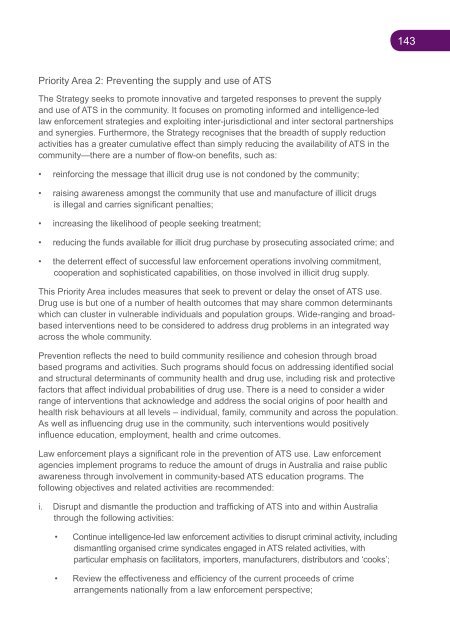National Amphetamine-Type Stimulant Strategy Background Paper
National Amphetamine-Type Stimulant Strategy Background Paper
National Amphetamine-Type Stimulant Strategy Background Paper
Create successful ePaper yourself
Turn your PDF publications into a flip-book with our unique Google optimized e-Paper software.
143<br />
Priority Area 2: Preventing the supply and use of ATS<br />
The <strong>Strategy</strong> seeks to promote innovative and targeted responses to prevent the supply<br />
and use of ATS in the community. It focuses on promoting informed and intelligence-led<br />
law enforcement strategies and exploiting inter-jurisdictional and inter sectoral partnerships<br />
and synergies. Furthermore, the <strong>Strategy</strong> recognises that the breadth of supply reduction<br />
activities has a greater cumulative effect than simply reducing the availability of ATS in the<br />
community—there are a number of flow-on benefits, such as:<br />
• reinforcing the message that illicit drug use is not condoned by the community;<br />
• raising awareness amongst the community that use and manufacture of illicit drugs<br />
is illegal and carries significant penalties;<br />
• increasing the likelihood of people seeking treatment;<br />
• reducing the funds available for illicit drug purchase by prosecuting associated crime; and<br />
• the deterrent effect of successful law enforcement operations involving commitment,<br />
cooperation and sophisticated capabilities, on those involved in illicit drug supply.<br />
This Priority Area includes measures that seek to prevent or delay the onset of ATS use.<br />
Drug use is but one of a number of health outcomes that may share common determinants<br />
which can cluster in vulnerable individuals and population groups. Wide-ranging and broadbased<br />
interventions need to be considered to address drug problems in an integrated way<br />
across the whole community.<br />
Prevention reflects the need to build community resilience and cohesion through broad<br />
based programs and activities. Such programs should focus on addressing identified social<br />
and structural determinants of community health and drug use, including risk and protective<br />
factors that affect individual probabilities of drug use. There is a need to consider a wider<br />
range of interventions that acknowledge and address the social origins of poor health and<br />
health risk behaviours at all levels – individual, family, community and across the population.<br />
As well as influencing drug use in the community, such interventions would positively<br />
influence education, employment, health and crime outcomes.<br />
Law enforcement plays a significant role in the prevention of ATS use. Law enforcement<br />
agencies implement programs to reduce the amount of drugs in Australia and raise public<br />
awareness through involvement in community-based ATS education programs. The<br />
following objectives and related activities are recommended:<br />
i. Disrupt and dismantle the production and trafficking of ATS into and within Australia<br />
through the following activities:<br />
• Continue intelligence-led law enforcement activities to disrupt criminal activity, including<br />
dismantling organised crime syndicates engaged in ATS related activities, with<br />
particular emphasis on facilitators, importers, manufacturers, distributors and ‘cooks’;<br />
• Review the effectiveness and efficiency of the current proceeds of crime<br />
arrangements nationally from a law enforcement perspective;

















